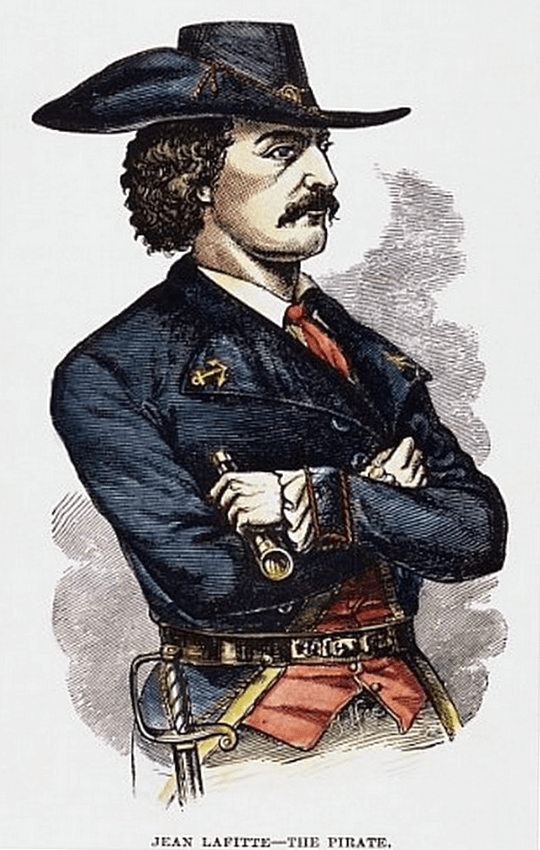Searching for Laffite the Pirate

Jean Laffite “The Corsair” by E.H. Suydam
Laffite the pirate, a curious fellow, has been evading the establishment. If once he escaped the sheriff, today he still eludes the historical authorities.
Who was the real Jean Laffite? Was he born in the former colony of St. Domingue or in the cities of Bayonne or Bordeaux? Did he die still practicing his trade as a pirate in the Yucatan in the middle 1820s or as a middle-class American citizen of the 1850s?
Should we judge him a cutthroat pirate, a patriotic privateer, or a gentleman rover? Why did he return to pirating after he received a pardon from President Madison for his support of Americans in the Battle of New Orleans? Why did he spy for Spain after the War of 1812 was over, when he claimed that his aim had always been to punish the Spanish for their cruelties? Did he really have a Jewish grandmother anyway, whom the Spanish persecuted?
Did he have a blacksmith shop on Bourbon Street? If so, where is a scrap of evidence connecting that famous tavern to him? What about his journal, now at the archives in Liberty, Texas? Is it real? Was it his or some other fellow’s of the 1840s? In it, the writer claims to love the downtrodden, hate the Spanish, respect the Declaration of Independence, and have contempt for the English. If Jean Laffite loved the downtrodden so keenly, why did he make a living smuggling slaves into America after Congress had prohibited their importation?
What can we all agree upon, or almost? He burst on the scene in the Gulf of Mexico about 1803, preying on shipping and selling smuggled slaves and merchandise from the swamps of Barataria. He thumbed his nose at the governor, “parading arm-in-arm on the streets of New Orleans with his buddies.”
The crafty lawyers Livingston and Grymes always managed to get his people out of jail when arrested for piracy. Laffite’s older brother Pierre sold slaves openly through notaries in New Orleans, but was jailed in 1814. He spent the summer in chains in the heat of the Calaboose on what would later be Jackson Square.
Dominique You and Renato Beluche were his compatriots in what German merchant Vincent Nolte described as a “colony of pirates” infesting the shores of Louisiana. They were all surprised by federal agents in September 1814 at Grand Terre island.
Not long later, Laffite turned down an offer from a British navy captain to join the Limeys in the ongoing War of 1812. Instead, he offered his troops to Governor William Claiborne, received a huffed refusal, and ended up being welcomed into the rag-tag American army by Andrew Jackson.
For the great Battle of January 8, 1815, he provided the flints and the gunpowder from his stolen stores in Barataria. With Jackson’s Kentuckians, his marksmen helped to trounce the advancing British army on that wintry battle morning. Armed with a pardon for his whole company, Laffite walked the streets of New Orleans a free man for a year or so afterward.
But law-abiding was not to his liking. He left the city to found a community of smugglers at Galveston and a new base for “privateering.” After the federal government got serious and blew him out of Galveston, he turned to the Yucatan and was never heard from again after the middle 1820s.
That is, until his “journal” surfaced. Uncannily authentic-looking, on genuine century-old paper, and written by a person who knew all the players, it surfaced in the 1940s. Its author had it in for the Spanish, mentioned all the right people, and had the right signature. He also spelled the name correctly, with two “F’s” and only one “T.”
Purportedly, Laffite had lived until the 1850s and died as a prosperous middle-class citizen with traceable posterity. The journal turned up with family papers in a trunk inherited by a purported descendant of an apparently parallel character.
For 50 years the “Journal of Jean Laffite” has stirred controversy worthy of its subject. Transcribed, translated from the French, and issued twice, it has writers scrambling to deal with its substance as well as its provenance. The persona that emerges from its pages is a moralistic, inwardly-focused paranoid with perfect recall of names and events and complete ignorance of his own failings.
This Laffite is not the suave gentleman depicted by historians. And yet they sensed from the beginning that there was something in the person in addition to a pirate.
Writers have been penning their thoughts on Laffite since the 1820s. A biographer of the 1950s claimed that he had so much evidence that no further work would be needed. Since that moment, eight more Laffite biographies have been published. And counting.
Sally Reeves is a noted writer, historian, translator, and archivist. She is known for her work in the New Orleans Notarial Archives as “Louisiana’s premier archivist” and her publications on New Orleans history.






